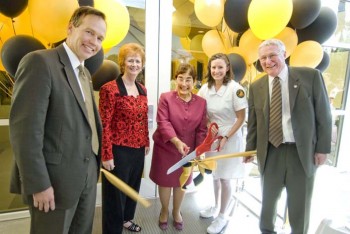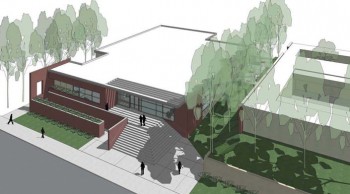
(L-R) CSULB President F. King Alexander, Nursing Alumni Association president Dr. Vivianne Lokken, School of Nursing director Loucine Huckabay, senior nursing student and president of CSULB’s chapter of the California Student Nursing Association Laura Speth, and College of Health and Human Services dean Ken Millar are on hand to cut the ribbon.
9:00am | Faculty at California State Long Beach welcomed a $4.3 million addition to the family on Monday, with the official dedication of the new 10,600-sq. gross foot School of Nursing building that will include teaching labs, a computer lab, support services, and faculty and administrative offices.
The project is the first addition to the university’s nursing facilities since 1975, and comes at a time of high demand for people entering the health workforce. Students will begin attending classes in the building in the Spring.
“You don’t know how happy I am,” said Loucine Huckabay, director of the CSULB School of Nursing. “This is indeed a day we have been waiting for many years, and this day was made possible through the efforts of many individuals, families and our wonderful service partners.”
 The expansion has been a necessity since 2004, when three local hospitals – Long Beach Memorial Hospital, Hoag Hospital and Long Beach Veterans Hospital – signed on to support the School of Nursing and enrollment nearly quadrupled overnight. That left only two classrooms to serve about 870 students. The new building adds three more classrooms and the computer lab to assist students.
The expansion has been a necessity since 2004, when three local hospitals – Long Beach Memorial Hospital, Hoag Hospital and Long Beach Veterans Hospital – signed on to support the School of Nursing and enrollment nearly quadrupled overnight. That left only two classrooms to serve about 870 students. The new building adds three more classrooms and the computer lab to assist students.
“Anytime we get the chance to do a ribbon-cutting on a new building, it is a great day for our university,” said CSULB President F. King Alexander. “But more importantly, any time we can do this in the type of horrific economy we’ve been dealing with is even more significant.”
The project was funded by a 2007 state appropriation of $2.3 million for preliminary designs, materials and planning. The rest came from donations to the School of Nursing.
The building will begin a new era as healthcare itself is changing. Officials believe new resources will prepare students better to serve the healthcare needs of all levels of society. After graduation, Huckabay said, about two-thirds of students choose to work in underserved areas.
“This is the place where professional nurses will be educated to transform the healthcare delivery system and meet the challenges of reform for the betterment of patient care,” Huckabay said. “As the largest component of the healthcare workforce, nurses are uniquely positioned to be in the forefront and take charge to ensure that acceptable, high quality care is available to all of our nation’s diverse populations.”

